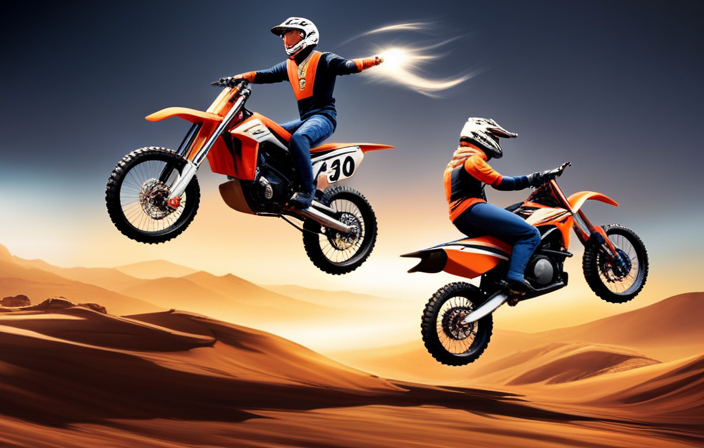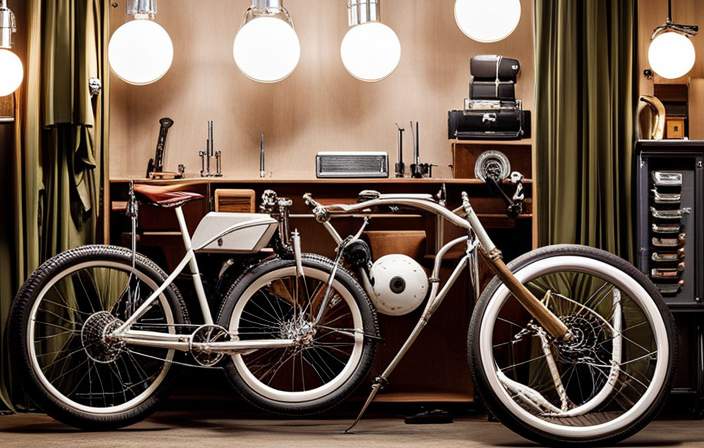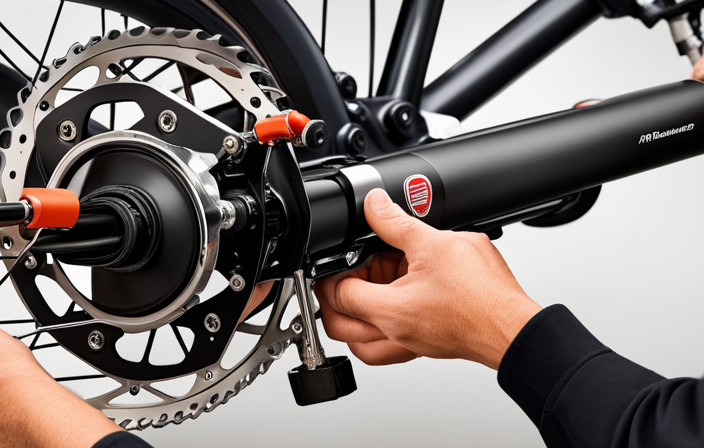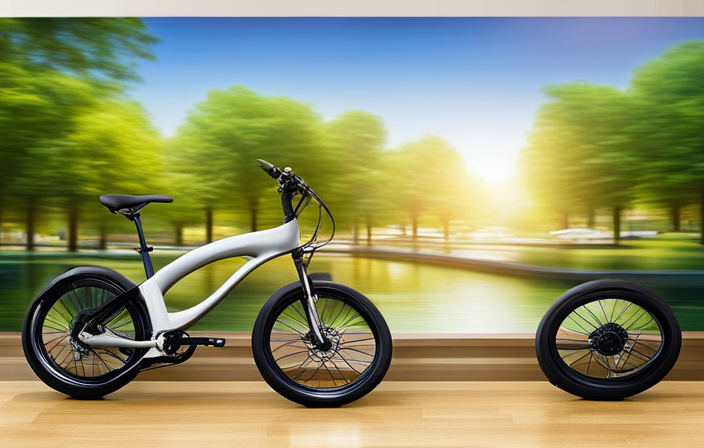When it comes to dirt bikes, the burning question is: which is faster, gas-powered or electric?
In this article, I’ll dive deep into the mechanics, advantages, and differences between these two powerhouses on wheels. We’ll analyze factors like acceleration, top speed, power, torque, maintenance, cost, battery life, range, and even noise levels.
By the end, you’ll have a clear understanding of which dirt bike is the speed demon you’ve been looking for.
So, let’s rev our engines and get started!
Key Takeaways
- Gas-powered dirt bikes have higher top speeds compared to electric bikes.
- Electric dirt bikes have an advantage in acceleration, allowing for easier navigation.
- Electric bikes offer a more environmentally friendly option, producing zero emissions.
- Electric bikes have lower maintenance costs in the long run, compared to gas-powered bikes.
Understanding the Mechanics of Gas-Powered Dirt Bikes
Gas-powered dirt bikes use a combustion engine to generate power and propel the bike forward. When exploring fuel efficiency, it’s essential to understand how these engines work.
The combustion engine relies on a mixture of fuel and air, which is ignited by a spark plug. This explosion creates the power needed to move the bike. However, this process also generates exhaust emissions, which can have environmental consequences.
Gas-powered dirt bikes tend to have higher fuel consumption and produce more emissions compared to electric dirt bikes. The use of fossil fuels in gas-powered bikes contributes to carbon dioxide emissions, which are a major contributor to climate change.
Understanding these mechanics and their impact on fuel efficiency and exhaust emissions is crucial when comparing gas-powered dirt bikes to their electric counterparts.
Exploring the Advantages of Electric-Powered Dirt Bikes
You’ll love the advantages of electric-powered dirt bikes. When it comes to the electric vs gas debate, electric dirt bikes have their own unique perks. Here are five reasons why electric-powered dirt bikes are worth considering:
-
Instant Torque: Electric dirt bikes deliver instant torque, providing quick acceleration and responsive handling.
-
Low Maintenance: With fewer moving parts and no need for oil changes or tune-ups, electric dirt bikes require less maintenance, saving you time and money.
-
Quiet Operation: Electric dirt bikes produce minimal noise, allowing for a more peaceful riding experience and reducing noise pollution.
-
Environmental Friendliness: Electric dirt bikes produce zero emissions, making them a cleaner and greener option for outdoor enthusiasts.
-
Cost Savings: While electric dirt bikes may have a higher upfront cost, they can save you money in the long run due to lower fuel and maintenance expenses.
When it comes to performance comparison between electric and gas-powered dirt bikes, electric models bring several advantages to the table.
Comparing Acceleration and Top Speed
Get ready to feel the thrill of quick acceleration and impressive top speeds when riding an electric-powered dirt bike.
When it comes to acceleration, electric dirt bikes have a clear advantage over their gas-powered counterparts. With instant torque delivery, electric bikes can launch off the line much faster, giving riders an exhilarating burst of speed right from the start. This quick acceleration allows riders to navigate through tricky terrain and conquer challenging obstacles with ease.
Additionally, electric dirt bikes can reach impressive top speeds that rival or even exceed those of gas-powered bikes. The combination of quick acceleration and high top speeds make electric dirt bikes a formidable choice for riders looking for a thrilling and high-performance off-road experience.
So, whether it’s the acceleration comparison or speed analysis, electric-powered dirt bikes are sure to leave riders feeling satisfied and exhilarated.
Analyzing Power and Torque Differences
Feel the difference in power and torque when riding an electric dirt bike compared to its gas-powered counterpart. When analyzing efficiency and comparing performance, it becomes clear that electric dirt bikes have their advantages.
While gas-powered dirt bikes rely on combustion engines that produce power through a series of explosions, electric dirt bikes utilize electric motors that deliver instant torque. This means that electric dirt bikes can accelerate quickly and smoothly, providing a thrilling riding experience.
Additionally, electric dirt bikes have the advantage of being more efficient, as they don’t require fuel and produce zero emissions.
The power and torque of an electric dirt bike may not match that of a gas-powered one, but the instantaneous acceleration and environmental benefits make it a viable option for riders seeking a different kind of thrill.
Evaluating Maintenance Requirements
Keep in mind that evaluating maintenance requirements is crucial when considering an electric dirt bike versus a gas-powered one.
While electric dirt bikes have fewer moving parts and require less regular maintenance, they do come with their own set of maintenance costs. The battery pack, for example, needs to be periodically replaced, which can be expensive.
On the other hand, gas-powered dirt bikes require regular oil changes, air filter replacements, and spark plug maintenance. These maintenance tasks are relatively inexpensive but need to be done more frequently compared to electric bikes.
When comparing performance longevity, electric dirt bikes tend to have a longer lifespan due to their simpler design and fewer mechanical components. However, gas-powered dirt bikes can also last a long time if properly maintained and serviced regularly.
Ultimately, evaluating maintenance costs and comparing performance longevity are important factors to consider when deciding between a gas-powered or electric dirt bike.
Considering Environmental Impact
When considering the environmental impact, it’s important to weigh the emissions produced by each type of dirt bike. Gas-powered dirt bikes emit pollutants such as carbon monoxide, nitrogen oxides, and hydrocarbons, which contribute to air pollution and have negative effects on air quality. On the other hand, electric dirt bikes produce zero emissions during operation, making them a cleaner and more sustainable option. Evaluating long-term sustainability is crucial when comparing the two options. While gas-powered dirt bikes rely on fossil fuels that are limited and contribute to climate change, electric dirt bikes can be powered by renewable energy sources, reducing their overall environmental footprint. To further analyze the environmental impact, let’s compare the emissions of a gas-powered dirt bike and an electric dirt bike in the table below:
| Emissions | Gas-Powered Dirt Bike | Electric Dirt Bike |
|---|---|---|
| Carbon Monoxide | High | None |
| Nitrogen Oxides | High | None |
| Hydrocarbons | High | None |
| Greenhouse Gases | High | None |
By evaluating the long-term sustainability and impact on air quality, it’s clear that electric dirt bikes are a more environmentally friendly option.
Factoring in Cost and Affordability
To determine the most cost-effective option, consider the prices and maintenance expenses associated with both types of dirt bikes.
Gas-powered dirt bikes typically have a lower upfront cost compared to electric bikes. However, when factoring in long-term savings, electric dirt bikes may prove to be more economical.
Gasoline prices continue to rise, and the cost of fuel for gas-powered bikes can add up over time. On the other hand, electric dirt bikes have lower maintenance costs since they do not require oil changes or spark plug replacements.
Additionally, electricity is generally cheaper than gasoline, resulting in lower operational costs for electric bikes.
While electric dirt bikes may have a higher initial price, the long-term savings in fuel and maintenance expenses make them a more affordable option in the long run.
Examining Battery Life and Range
If you’re considering an electric dirt bike, it’s important to examine the battery life and how far you can ride on a single charge. Battery performance plays a crucial role in determining the practicality and usability of an electric dirt bike. Here are a few key points to consider:
-
Battery Capacity: The size and capacity of the battery will directly affect the range you can achieve on a single charge. Higher capacity batteries can provide longer rides before needing to be recharged.
-
Riding Conditions: Factors like terrain, speed, and rider weight can impact battery performance. Riding uphill or at high speeds will drain the battery faster.
-
Charging Time: It’s essential to understand how long it takes to recharge the battery fully. Some electric dirt bikes may have faster charging times than others.
-
Charging Infrastructure: The availability of charging stations or outlets can significantly impact the usability of an electric dirt bike. Access to convenient charging locations can provide more flexibility for longer rides.
Considering these aspects of battery life and range, along with the overall charging infrastructure, will help you make an informed decision when choosing an electric dirt bike.
Assessing Noise Levels
Assessing noise levels is important for determining the impact an electric dirt bike will have on your surroundings. Electric dirt bikes are known for their quiet operation, which is a significant advantage over gas-powered bikes. The absence of engine noise not only reduces disturbance to wildlife and nearby residents but also enhances the overall riding experience.
In addition to noise levels, assessing emission levels is another crucial aspect. Electric dirt bikes produce zero emissions, making them environmentally friendly and reducing air pollution. They can be charged using renewable energy sources, further reducing their carbon footprint.
When comparing fuel efficiency, electric dirt bikes are also more efficient than their gas counterparts. They can be charged using renewable energy sources, further reducing their carbon footprint.
Overall, assessing noise levels, emission levels, and fuel efficiency are essential factors to consider when deciding between a gas or electric dirt bike.
Choosing the Right Dirt Bike for Your Needs
Finding the right dirt bike for your needs can be a challenging task. When comparing gas and electric dirt bikes, there are a few factors to consider.
Gas-powered bikes are generally more powerful and have a longer range, making them ideal for off-road adventures that require endurance. On the other hand, electric dirt bikes are quieter and have instant torque, providing a smooth and responsive ride. They are also more environmentally friendly and low maintenance.
When deciding between the two, it’s important to think about your riding style, terrain, and personal preferences. Gas bikes are better suited for long rides and rough terrains, while electric bikes are great for shorter rides and urban environments.
Ultimately, the choice between gas and electric comes down to personal preference and the type of riding you plan to do.
Frequently Asked Questions
What is the average lifespan of a gas-powered dirt bike?
The average lifespan of a gas-powered dirt bike depends on several factors, including maintenance requirements. With proper care and regular servicing, a gas-powered dirt bike can typically last for several years before needing significant repairs or replacement parts.
Can an electric-powered dirt bike be charged using a regular household outlet?
Charging an electric dirt bike using a regular household outlet is possible. The charging time varies, but it offers numerous benefits like eco-friendliness, lower maintenance, and quieter operation.
Are there any specific safety concerns associated with gas-powered dirt bikes?
Gas-powered dirt bikes have specific safety concerns due to the flammable nature of gasoline. They require regular maintenance, such as fueling, oil changes, and spark plug checks. Proper safety precautions, like wearing protective gear, are crucial when operating gas-powered dirt bikes.
How does the resale value of an electric-powered dirt bike compare to a gas-powered one?
When comparing the resale value of electric-powered and gas-powered dirt bikes, it’s important to consider maintenance costs. Electric bikes generally have lower maintenance costs, which can positively impact their resale value compared to gas-powered bikes.
Are there any restrictions or limitations on where you can ride an electric-powered dirt bike?
There are some restrictions and limitations when it comes to riding electric dirt bikes. These can vary depending on the specific area and local regulations. However, there are dedicated off-road electric bike trails available in certain locations.
Conclusion
In conclusion, when choosing between a gas-powered or electric dirt bike, it is important to consider your specific needs and preferences.
While gas-powered dirt bikes may offer faster acceleration and higher top speeds, electric dirt bikes have their own advantages. These include lower maintenance requirements, quieter operation, and potentially lower long-term costs.
While some may argue that gas-powered dirt bikes are more powerful, it is worth noting that electric dirt bikes are constantly improving and closing the performance gap.
Ultimately, the decision comes down to personal preference and the specific requirements of the rider.









